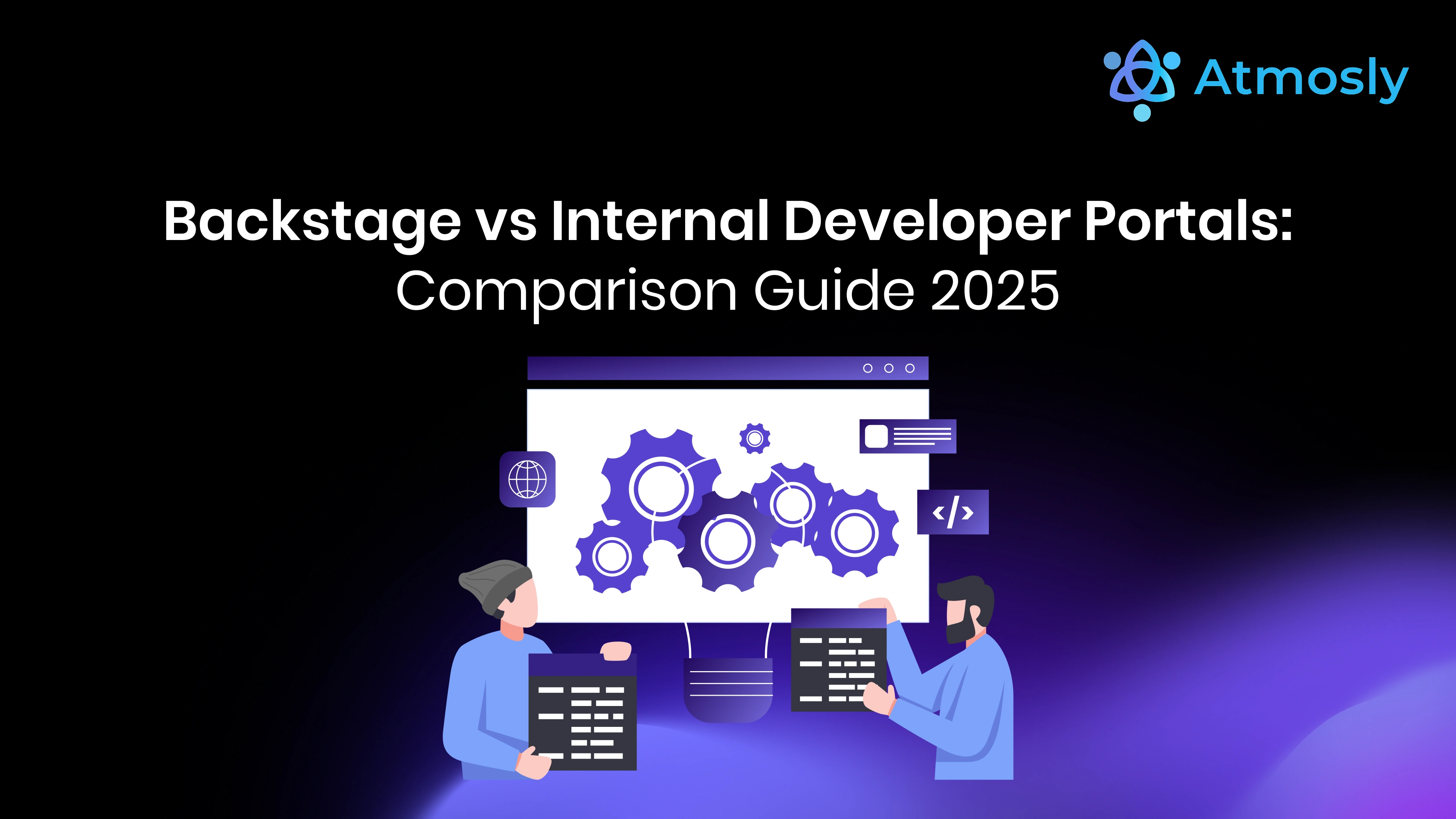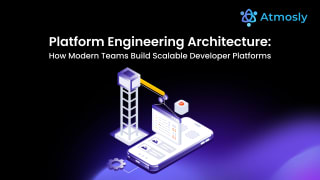As software systems grow more complex, the need for streamlined developer experiences has never been greater. Developers today juggle microservices, APIs, cloud infrastructure, Kubernetes clusters, CI/CD pipelines, and security requirements all while racing against deadlines. Without the right tooling, this complexity slows teams down, introduces errors, and creates operational chaos.
Enter Internal Developer Portals (IDPs) self-service hubs designed to simplify developer workflows by centralizing access to tools, services, and environments. One of the most well-known names in this space is Backstage, an open-source platform created by Spotify. At the same time, commercial IDPs have emerged, offering faster time-to-value and integrated automation.
This article provides a detailed comparison between Backstage and Internal Developer Portals in 2025, exploring their definitions, features, pros and cons, and how to choose the right approach for your organization.
1. What is an Internal Developer Portal?
An Internal Developer Portal (IDP) is a centralized platform that gives developers self-service access to everything they need to build, test, and deploy applications. Instead of hunting through documentation, scripts, or asking DevOps engineers for support, developers use an IDP to:
- Provision infrastructure and environments.
- Spin up new microservices or pipelines.
- Access service catalogs and APIs.
- Monitor deployments and application health.
- Manage compliance and security guardrails.
The benefits of IDPs are clear:
- Faster onboarding – new developers can start building within hours instead of weeks.
- Reduced cognitive load – developers don’t need to understand every detail of infrastructure.
- Improved DevOps automation – repetitive manual tasks become streamlined.
- Better developer experience – teams focus on coding, not plumbing.
As organizations adopt platform engineering, IDPs have become the backbone for scaling DevOps practices.
2. What is Backstage?
Backstage is an open-source Internal Developer Portal developed by Spotify to solve its own platform engineering challenges. It was later contributed to the Cloud Native Computing Foundation (CNCF) and is now one of the most widely recognized IDP frameworks.
Key Features of Backstage
- Service Catalog: Centralized directory for all services and microservices.
- Software Templates: Quickly scaffold new services or components with pre-defined templates.
- Plugin Ecosystem: Extend functionality with community-built or custom plugins.
- TechDocs: Unified documentation system for services and APIs.
- Customization: Offers high flexibility for teams willing to invest in development.
Strengths of Backstage
- Open-source with a large, active community.
- Extremely customizable for enterprises with unique needs.
- Strong ecosystem of plugins and contributors.
- CNCF backing provides long-term stability.
Limitations of Backstage
- Requires significant setup and maintenance.
- Best suited for organizations with dedicated platform engineering teams.
- Time-to-value can be slow often months before fully usable.
- Out-of-the-box experience is limited; most value comes from custom development.
3. The Rise of Commercial/Internal Developer Portals
While Backstage is powerful, many organizations, especially startups and scaleups find it too heavy. This has given rise to commercial Internal Developer Portals (IDPs) that are turnkey, cloud-hosted, and managed.
Examples of Commercial IDPs
- Port – a self-service platform for developers with service catalogs and workflows.
- Cortex – focused on service ownership and scorecards.
- Humanitec – environment and workload management.
- Atmosly – a modern IDP combined with DevOps automation, offering AI Copilot for Kubernetes, one-click environment cloning, pipeline builder, and cost intelligence.
Benefits of Commercial IDPs
- Faster setup: From days to weeks, of months.
- Managed infrastructure: No need to host or maintain yourself.
- AI/automation baked in: Features such as cost optimization and automated troubleshooting.
- Fewer engineers required: Suited for lean DevOps or platform teams.
For many organizations, these trade-offs make commercial IDPs more practical than building a Backstage instance from scratch.
4. Backstage vs Internal Developer Portals: Key Differences
The table below summarizes the main differences between Backstage and commercial IDPs:
Criteria | Backstage | Internal Developer Portals (IDPs) |
| Setup & Maintenance | Self-hosted, requires infra + dedicated team | Managed / SaaS options available, minimal setup |
| Customization | Highly customizable with plugins and code | Customization via workflows, but limited deep engineering |
| Time to Value | Months (depending on team size) | Days to weeks |
| Ecosystem | Rich open-source community, plugins | Vendor-driven features and integrations |
| Scalability | Scales well, but you manage infra | Scales easily with provider infrastructure |
| Costs | Free software, but hidden costs (infra, engineers) | Subscription-based, transparent pricing |
| Security & Compliance | Depends on internal implementation | Built-in governance and compliance controls |
| AI/Automation | Minimal (depends on plugins) | Often includes AI (e.g., Atmosly’s AI Copilot) |
| Best For | Large enterprises with platform engineering teams | Startups, scaleups, or enterprises wanting speed |
5. Pros and Cons of Backstage
Pros
- Free and open-source.
- Strong plugin ecosystem.
- Backed by Spotify and CNCF, stable future.
- Flexible and customizable for enterprises.
Cons
- Complex to deploy and maintain.
- Steep learning curve for teams.
- Requires significant engineering investment.
- Time-to-value is long compared to commercial IDPs.
6. Pros and Cons of Commercial IDPs
Pros
- Easy to set up and use (SaaS, managed).
- AI and automation features included.
- Faster onboarding for developers.
- Transparent subscription pricing.
- Scales easily without infrastructure management.
Cons
- Vendor lock-in, tied to a provider’s ecosystem.
- Less flexibility for deep customization.
- May lack the open-source community of Backstage.
7. When Should You Choose Backstage vs an Internal Developer Portal?
The choice between Backstage and a commercial IDP depends on your organization’s size, maturity, and goals.
Choose Backstage if:
- You are a large enterprise with 50+ developers.
- You have a dedicated platform engineering team to maintain it.
- You need deep customization and control.
- You want to leverage the open-source ecosystem.
Choose a Commercial IDP if:
- You are a startup or scaleup that needs speed.
- You don’t have the resources for a dedicated platform team.
- You want faster time-to-value (days, not months).
- You prefer built-in AI/automation features like cost intelligence or self-healing.
Hybrid Approach
Some organizations start with a commercial IDP for speed, then migrate to Backstage as they grow and build internal expertise. Others integrate both using Backstage as the base framework while layering vendor solutions on top for automation.
8. The Future of Internal Developer Portals
The IDP landscape is evolving rapidly, with several key trends shaping its future:
- AI-Driven Portals – Expect automation of troubleshooting, anomaly detection, and cost optimization. Platforms like Atmosly already provide AI copilots for Kubernetes.
- Shift to Developer Experience Platforms (DXPs) – IDPs will evolve beyond service catalogs into full-fledged platforms designed to improve the developer experience.
- GitOps Integration – Declarative and automated infrastructure management will become the norm.
- Policy-as-Code & Compliance Automation – Security guardrails will be embedded automatically in developer workflows.
- Hybrid Models – Organizations may combine Backstage with commercial IDPs for the best of both worlds.
9. Conclusion
Choosing between Backstage and Internal Developer Portals depends on where your organization stands. Backstage offers flexibility and control but requires significant investment in time and resources. Commercial IDPs deliver speed, simplicity, and AI-driven automation, making them ideal for startups, scaleups, and enterprises that want results fast.
If you’re looking for a modern solution that blends IDP capabilities with DevOps automation, Atmosly is worth exploring. With features like AI Copilot for Kubernetes, one-click environment cloning, visual pipeline builder, and cost intelligence, Atmosly simplifies complexity and empowers developers to move faster.
In 2025, the right choice isn’t just about Backstage vs IDPs, it’s about finding the platform that matches your team’s goals, skills, and growth journey.






